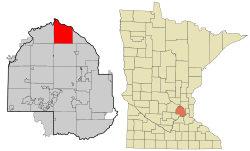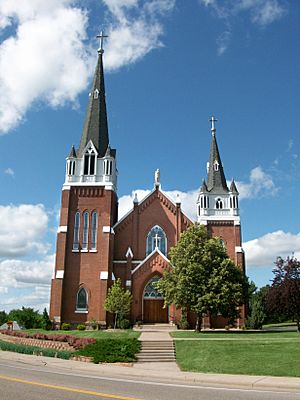Dayton, Minnesota facts for kids
Quick facts for kids
Dayton, Minnesota
|
|
|---|---|

Location of the city of Dayton
within Hennepin County, Minnesota |
|
| Country | United States |
| State | Minnesota |
| Counties | Hennepin, Wright |
| Settled | 1851 |
| Platted | 1855 |
| Named for | Lyman Dayton |
| Area | |
| • Total | 25.182 sq mi (65.221 km2) |
| • Land | 23.419 sq mi (60.655 km2) |
| • Water | 1.763 sq mi (4.565 km2) |
| Elevation | 879 ft (268 m) |
| Population
(2020)
|
|
| • Total | 7,262 |
| • Estimate
(2023)
|
10,157 |
| • Density | 434.0/sq mi (167.5/km2) |
| Time zone | UTC–6 (Central) |
| • Summer (DST) | UTC–5 (CDT) |
| ZIP Code |
55327
|
| Area code(s) | 763 |
| FIPS code | 27-15022 |
| GNIS feature ID | 0642665 |
| Sales tax | 8.525% |
Dayton is a city in Minnesota, located in both Hennepin and Wright counties. In 2020, about 7,262 people lived there. By 2023, it was estimated that the population grew to over 10,000 people!
Most of Dayton is in Hennepin County, but a small part reaches into Wright County. It's the northernmost city in Hennepin County. Dayton is also a suburb of the Minneapolis–St. Paul area, often called the "Twin Cities."
The city of Dayton was planned out in 1855. It was named after its founder, Lyman Dayton. He was very important in bringing railroads to Minnesota. He helped develop the Lake Superior and Mississippi Railroad, and he was its president for many years. This railroad line is now part of the Burlington Northern Santa Fe Railroad.
Contents
Dayton's Location and Rivers
Dayton covers about 25 square miles (65 square kilometers). Most of this area is land, with a smaller part being water. The city's boundaries were last expanded in 2003.
Several main roads run through Dayton, including Fernbrook Lane, North Diamond Lake Road, South Diamond Lake Road, and Dayton River Road. Interstate 94 and County Road 81 also pass through a small part of the city. Brockton Lane runs along Dayton's western edge, next to the city of Rogers.
Dayton is surrounded by other cities like Champlin, Rogers, Maple Grove, Anoka, Ramsey, Elk River, and Otsego.
A cool fact about Dayton is that it's located where two important rivers meet: the Mississippi River and the Crow River.
Dayton's Economy
Dayton has a smaller economy compared to bigger cities. It has only a few retail stores. Most of Dayton's businesses are small, like its golf course, car repair shops, a famous local manor, and companies that build custom homes. The city's only mall, Raintree Plaza, has a gas station and convenience store, plus a few other small shops.
Dayton's Population Over Time
| Historical population | |||
|---|---|---|---|
| Census | Pop. | %± | |
| 1880 | 255 | — | |
| 1910 | 343 | — | |
| 1920 | 299 | −12.8% | |
| 1930 | 265 | −11.4% | |
| 1940 | 253 | −4.5% | |
| 1950 | 363 | 43.5% | |
| 1960 | 456 | 25.6% | |
| 1970 | 517 | 13.4% | |
| 1980 | 4,070 | 687.2% | |
| 1990 | 4,443 | 9.2% | |
| 2000 | 4,699 | 5.8% | |
| 2010 | 4,671 | −0.6% | |
| 2020 | 7,262 | 55.5% | |
| 2023 (est.) | 10,157 | 117.4% | |
| U.S. Decennial Census 2020 Census |
|||
| Historical population | |||
|---|---|---|---|
| Census | Pop. | %± | |
| 1860 | 540 | — | |
| 1870 | 951 | 76.1% | |
| 1880 | 1,197 | 25.9% | |
| 1890 | 1,075 | −10.2% | |
| 1900 | 1,138 | 5.9% | |
| 1910 | 778 | −31.6% | |
| 1920 | 744 | −4.4% | |
| 1930 | 718 | −3.5% | |
| 1940 | 741 | 3.2% | |
| 1950 | 715 | −3.5% | |
| 1960 | 804 | 12.4% | |
| 1970 | 2,162 | 168.9% | |
| U.S. Census for Dayton Township | |||
Dayton's Population in 2020
In 2020, there were 7,262 people living in Dayton. There were about 2,458 households, and 2,035 of these were families.
Here's a quick look at the different groups of people living in Dayton in 2020:
- About 79.3% of the people were White (not Hispanic or Latino).
- About 3.2% were Black or African American (not Hispanic or Latino).
- About 0.3% were Native American or Alaska Native (not Hispanic or Latino).
- About 2.9% were Asian (not Hispanic or Latino).
- About 0.5% were from some other race (not Hispanic or Latino).
- About 4.1% were of two or more races (not Hispanic or Latino).
- About 9.7% of the total population was Hispanic or Latino (who can be of any race).
Dayton's Population in 2010
In 2010, Dayton had 4,671 people. There were 1,638 households, and 1,319 of these were families.
Most people in Dayton were White (93.7%). Other groups included Asian (2.0%), African American (0.5%), and Native American (0.2%). About 8.8% of the population was Hispanic or Latino.
In 2010, about 35.5% of households had children under 18. Most households (66.8%) were married couples. The average household had about 2.85 people.
The average age in the city was 41.7 years. About 24.6% of residents were under 18, and 9% were 65 or older. The population was slightly more male (52.2%) than female (47.8%).
Points of Interest
One special place in Dayton is the St. John the Baptist Catholic Church. It was built in 1904. This church is so tall that you can see it from miles away, even from four different counties!
See also
 In Spanish: Dayton (Minnesota) para niños
In Spanish: Dayton (Minnesota) para niños


